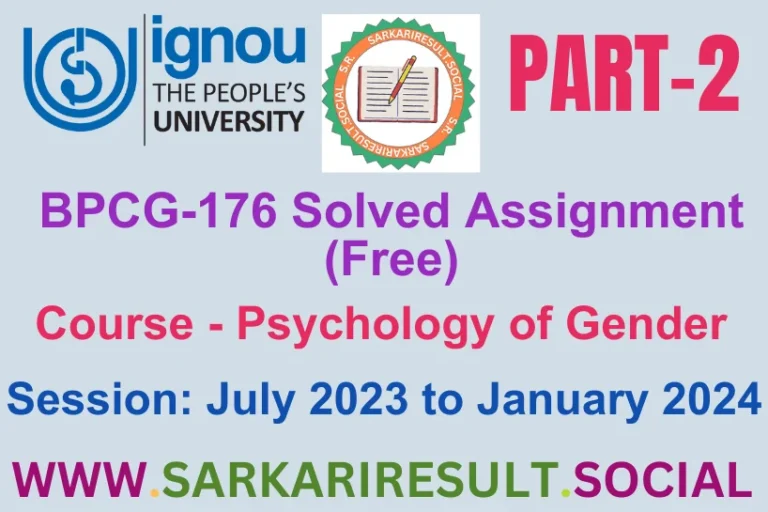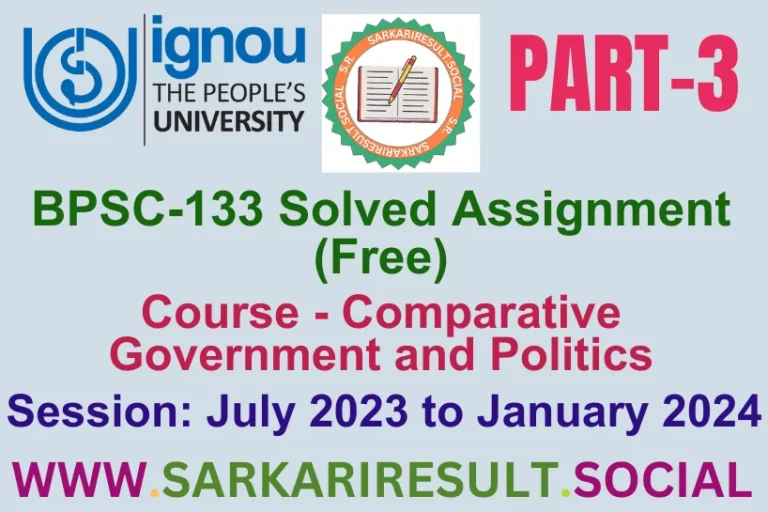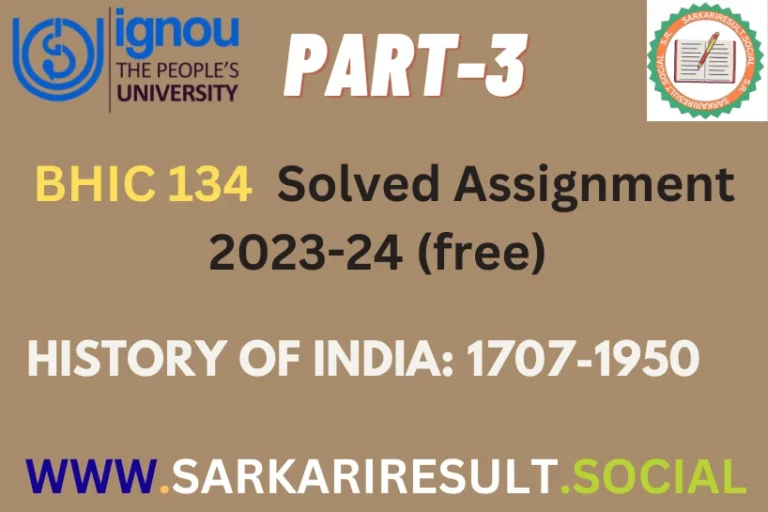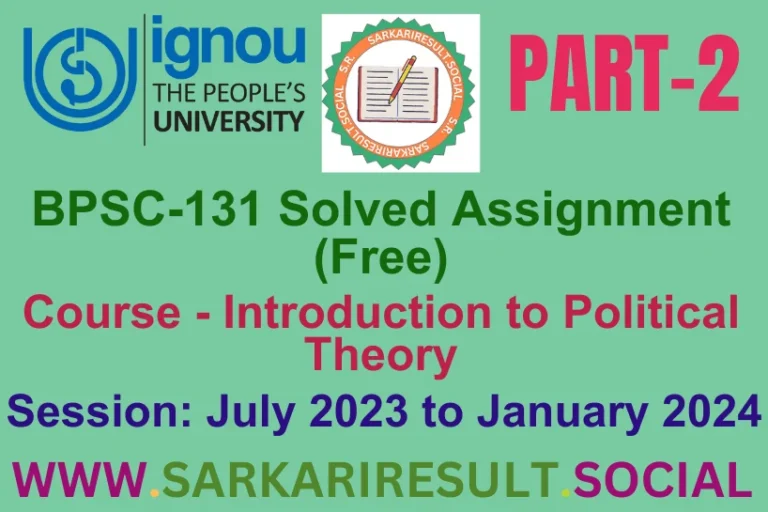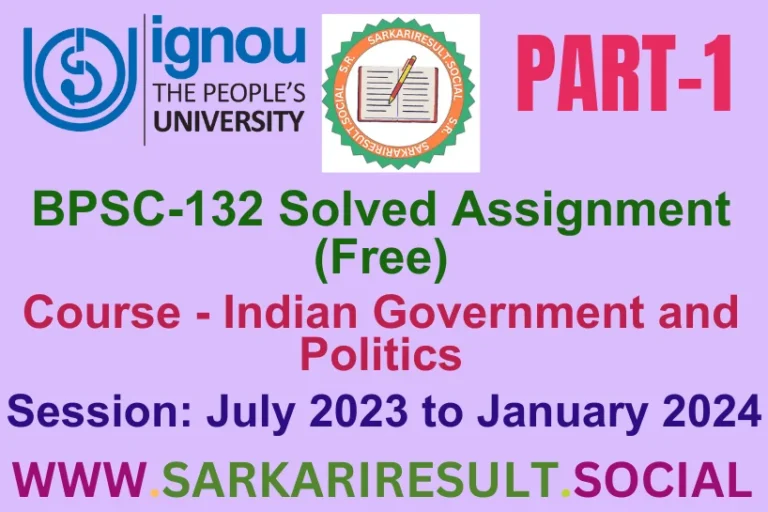Check “latest” BPCG 175 Ignou Solved Assignment (Free) in 2023-24

BPCG 175 Ignou Solved Assignment (Free) in 2023-24
BPCG 175 Ignou Solved Assignment (Free) in 2023-24-IGNOU offers a key course called BPCG 175 called “Psychology for Living.” The practical applications of psychology to numerous facets of daily life are covered in depth in this course. It is essential for attaining personal growth and healthy relationships to have a thorough understanding of human behavior, emotions, and mental processes. The submission of assignments is essential for academic assessment in this course and for encouraging the application of psychological concepts to practical circumstances. This website provides students with the educational path by delivering direction, time efficiency, and access to high-quality resources by supplying free solved assignments for BPCG 175. Students should, however, use these completed tasks properly and combine their expertise to create unique answers.
Questions and Answers (Solved)
Section A

Q.1 Describe the nature and stages of creativity. Elucidate the factors influencing creativity and ways to enhance creativity.
Ans. Creativity is a multifaceted and complex process that involves generating novel and valuable ideas or solutions. It is not limited to artistic endeavors but is applicable in various domains, including science, technology, business, and everyday problem-solving. The nature of creativity can be described through the following stages:
- Preparation: This stage involves gathering knowledge, information, and experiences relevant to the creative task. Individuals immerse themselves in the subject matter, research, and explore various perspectives, laying the groundwork for innovative thinking.
- Incubation: During incubation, the mind unconsciously processes the gathered information, allowing ideas to percolate and connections to form subconsciously. This stage may involve a break from focused thinking, as the brain continues to work on the problem in the background.
- Illumination: Often referred to as the “aha moment,” illumination is when the creative breakthrough occurs. It is the sudden realization of a new idea, concept, or solution. This stage is characterized by a burst of insight, which may seem to come out of nowhere.
- Evaluation: After the illumination stage, the creative idea needs to be evaluated for its usefulness, feasibility, and effectiveness. Critical thinking and analysis play a crucial role in determining whether the idea is worth pursuing further.
- Elaboration: In this final stage, the creative idea is developed and refined. It involves putting the idea into action, fleshing out the details, and transforming it into a tangible form.
Factors Influencing Creativity:
Several factors can influence an individual’s creative potential and output:
- Knowledge and Expertise: A strong foundation of knowledge and expertise in a particular domain provides a rich pool of information from which creative ideas can emerge.
- Openness to Experience: Being open-minded and receptive to new ideas, experiences, and perspectives enhances creative thinking.
- Motivation: Intrinsic motivation, passion, and genuine interest in the task stimulate creativity.
- Environment: A supportive and encouraging environment that fosters risk-taking, experimentation, and autonomy can boost creativity.
- Diverse Inputs: Exposure to diverse stimuli, cultures, and viewpoints broadens one’s creativity by providing different sources of inspiration.
Ways to Enhance Creativity:
- Mindfulness and Reflection: Practicing mindfulness and taking time for self-reflection can stimulate creative insights by allowing individuals to tap into their subconscious thoughts.
- Brainstorming and Collaboration: Engaging in brainstorming sessions with others and collaborating on creative projects can generate a wider range of ideas.
- Divergent Thinking: Encouraging divergent thinking involves exploring multiple possibilities and solutions, pushing beyond conventional boundaries.
- Embrace Failure: Viewing failure as a stepping stone to success encourages risk-taking and resilience, crucial for creative breakthroughs.
- Continuous Learning: Cultivating a habit of continuous learning and exploring new subjects broadens one’s knowledge base, providing more fodder for creativity.
- Mind Mapping and Visualization: Techniques like mind mapping and visualization can help organize thoughts and make connections between seemingly unrelated ideas.
- Breaks and Play: Taking breaks and engaging in playful activities can relax the mind and stimulate creativity during the incubation stage.
Q.2 Explain the meaning and process of counseling.
Ans. Meaning and Process of Counseling: Counseling is a therapeutic process that involves a professional relationship between a trained counselor and a client seeking guidance and support to address various personal, emotional, psychological, and behavioral challenges.
The primary objective of counseling is to help individuals explore their thoughts, feelings, and behaviors, gain insights into their issues, and develop coping strategies to lead a more fulfilling and balanced life. It is a collaborative and confidential process that encourages self-exploration and personal growth.
Process of Counseling:
- Establishing Rapport: The first step in counseling is building a strong rapport between the counselor and the client. The counselor creates a safe, non-judgmental, and empathetic environment where the client feels comfortable sharing their concerns.
- Assessment and Goal Setting: The counselor assesses the client’s concerns, personal history, and current challenges to gain a comprehensive understanding of their unique situation. Together, they identify specific goals and outcomes that the client wants to achieve through counseling.
- Exploration and Insight: During the counseling sessions, the counselor encourages the client to explore their thoughts, emotions, and behavioral patterns. They may delve into past experiences and relationships to gain insight into how these factors may be influencing the client’s current challenges.
- Applying Therapeutic Techniques: Counselors use a variety of therapeutic techniques and interventions tailored to the client’s needs and goals. These may include cognitive-behavioral therapy (CBT), psychodynamic therapy, mindfulness-based techniques, and more.
- Empowerment and Self-Awareness: Through the counseling process, clients gain a deeper understanding of themselves, their strengths, and areas for growth. This self-awareness empowers them to make positive changes and take responsibility for their actions.
- Challenging Negative Patterns: Counselors assist clients in identifying and challenging negative thought patterns and behaviors that may be hindering their personal growth and well-being.
- Developing Coping Strategies: Clients learn and practice healthy coping strategies to manage stress, anxiety, and other emotional challenges more effectively.
- Working Through Emotions: Counseling provides a safe space for clients to express and process their emotions, helping them work through difficult feelings and experiences.
- Monitoring Progress: Throughout the counseling process, the counselor and client regularly review and assess progress toward the established goals. Adjustments may be made to the counseling approach as needed.
- Closure and Termination: As clients achieve their counseling goals or feel sufficiently equipped to navigate their challenges, the counseling process comes to a close. The counselor and client discuss the progress made and potential strategies for maintaining positive changes in the future.
- Follow-Up and Aftercare: In some cases, counselors may offer follow-up sessions or provide referrals for additional support, ensuring clients continue to receive assistance beyond the formal counseling process.
Section B
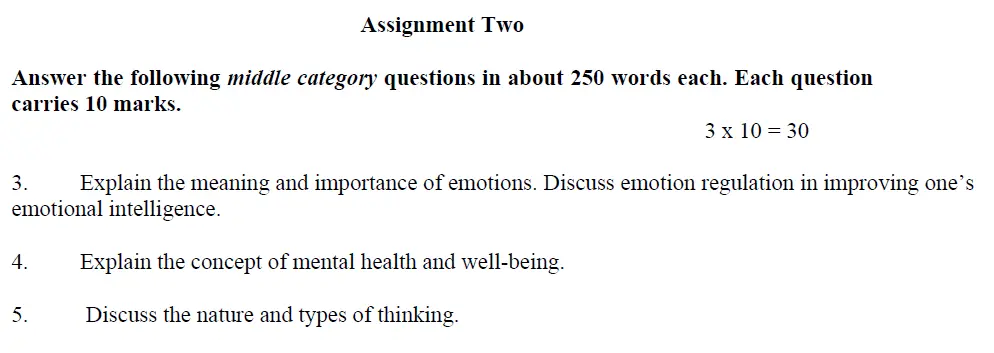
Q.3 Explain the meaning and importance of emotions. Discuss emotion regulation in improving one’s emotional intelligence.
Ans. Emotions are complex psychological and physiological responses that play a significant role in human behavior and social interactions. They encompass a wide range of feelings and serve as signals that communicate our internal states and needs. Emotions are crucial for decision-making, social bonding, adaptation, communication, and overall well-being.
Emotion regulation is the ability to effectively manage and modify emotional responses. It is a vital component of emotional intelligence, which involves recognizing, understanding, and managing emotions in oneself and others. Emotion regulation can improve emotional intelligence in various ways.
Firstly, it enhances self-awareness by helping individuals recognize and understand their emotional states. This insight promotes emotional understanding and self-reflection. Secondly, emotion regulation empowers individuals to exercise self-control over impulsive reactions, leading to more thoughtful and appropriate responses in various situations.
Moreover, it fosters empathy, as individuals who are in tune with their emotions can better understand and connect with the feelings of others. Additionally, effective emotion regulation aids conflict resolution by promoting open communication and composed behavior during difficult interactions.
Furthermore, emotion regulation helps in stress management, reducing stress and promoting emotional well-being. It also contributes to resilience, enabling individuals to bounce back from setbacks and challenges more effectively.
In conclusion, emotions are essential aspects of human life, influencing behavior and social connections. Emotion regulation, a crucial component of emotional intelligence, allows individuals to enhance self-awareness, self-control, empathy, conflict resolution, stress management, and resilience. Developing effective emotion regulation skills can significantly improve emotional intelligence and overall well-being.
Q.4 Explain the concept of mental health and well-being.
Ans. Mental health and well-being are fundamental aspects of human health that encompass the psychological, emotional, and social dimensions of an individual’s life.
Key aspects of mental health include:
- Emotional Resilience: The ability to adapt and cope with adversity, stress, and life’s challenges in a healthy manner.
- Emotional Intelligence: Being aware of and understanding one’s emotions and effectively managing them in various situations.
- Positive Self-Esteem: Having a healthy sense of self-worth and self-acceptance, which forms the foundation for positive mental well-being.
- Social Connections: Maintaining fulfilling relationships and having a support network that promotes a sense of belonging and connectedness.
- Work-Life Balance: Achieving a balance between work, personal life, and leisure activities to reduce stress and enhance overall well-being.
Mental well-being, on the other hand, refers to the state of flourishing and thriving in one’s mental health. It involves experiencing positive emotions, having a sense of purpose and meaning in life, and functioning optimally in various aspects of life.
The Importance of Mental Health and Well-being:
Mental health and well-being are critical for several reasons:
- Physical Health: Mental health influences physical health, as emotional well-being impacts the immune system, cardiovascular health, and overall bodily functions.
- Productivity and Performance: Positive mental health enhances productivity and performance in personal and professional domains.
- Relationships: Mental well-being contributes to healthy relationships and effective communication with others.
- Resilience: Good mental health fosters resilience, allowing individuals to bounce back from challenges and trauma.
- Reduced Stigma: Fostering mental health awareness reduces the stigma surrounding mental health issues and encourages seeking help when needed.
Q.5 Discuss the nature and types of thinking.
Ans. Thinking is the cognitive process of processing information, forming thoughts, and making sense of the world around us. It involves mental activities such as reasoning, problem-solving, decision-making, and creativity. The nature of thinking is multifaceted, and various types of thinking contribute to our cognitive abilities.
Thinking is the cognitive process of processing information, forming thoughts, and making sense of the world around us. It involves mental activities such as reasoning, problem-solving, decision-making, and creativity. The nature of thinking is multifaceted, and various types of thinking contribute to our cognitive abilities.
Nature of Thinking: Thinking is a cognitive process that helps us understand the world. It includes abstract, logical, critical, creative, and analytical thinking. Abstract thinking deals with complex concepts, logical thinking uses reasoning, critical thinking evaluates information, creative thinking generates new ideas, and analytical thinking breaks down information.
These types of thinking enhance problem-solving and decision-making abilities, enabling us to adapt to challenges and make informed choices.
Types of Thinking:
- Divergent Thinking: Divergent thinking is a form of creative thinking that involves generating multiple solutions or ideas from a single starting point.
- Convergent Thinking: Convergent thinking is the opposite of divergent thinking. It involves finding a single, correct solution to a well-defined problem through logical reasoning.
- Lateral Thinking: Lateral thinking encourages approaching problems from unconventional angles and exploring alternative perspectives.
- Critical Thinking: As mentioned earlier, critical thinking involves assessing and evaluating information to make informed decisions or judgments.
- Holistic Thinking: Holistic thinking involves considering the interconnectedness of various elements and understanding how they influence the whole system.
- Inductive Thinking: Inductive thinking involves reasoning from specific instances or examples to general conclusions.
- Deductive Thinking: Deductive thinking involves drawing specific conclusions from general principles or premises.
Section C

Q.6 Characteristics of dysfunctional attitudes.
Ans. Dysfunctional attitudes are negative and irrational beliefs that individuals hold about themselves, others, and the world. These attitudes often stem from past experiences and can lead to distorted perceptions, low self-esteem, and difficulties in coping with stress. Some characteristics of dysfunctional attitudes include perfectionism, self-blame, black-and-white thinking, and a tendency to magnify problems. These attitudes can significantly impact mental health and overall well-being.
Q.7 Indian perspective on personality.
Ans. In Indian culture, personality is often seen as a result of a person’s character, behavior, and virtues. It is influenced by various factors, including family values, cultural norms, and spiritual beliefs. The concept of personality in India emphasizes virtues such as humility, compassion, and selflessness. The Indian perspective on personality also acknowledges the interconnectedness of individuals with their community and nature. Yoga, meditation, and mindfulness practices are often used to develop and nurture a balanced and harmonious personality.
Q.8 Biopsychosocial model.
Ans. The biopsychosocial model is a comprehensive approach to understanding health and illness. It considers biological, psychological, and social factors that influence an individual’s well-being. This model recognizes that physical health is not solely determined by biological factors but also influenced by psychological and social aspects. It highlights the interplay between genetics, mental health, lifestyle, social support, and cultural factors in shaping a person’s overall health. The biopsychosocial model is widely used in healthcare to provide a holistic understanding of patients’ conditions and to develop personalized treatment plans.
Q.9 Ethics in counseling.
Ans. Ethics in counseling refer to the principles and guidelines that govern the ethical conduct of counselors in their professional practice. It includes maintaining confidentiality, respecting clients’ autonomy and privacy, obtaining informed consent, and avoiding conflicts of interest. Counselors are expected to adhere to ethical standards to ensure the well-being and trust of their clients. Ethical practice also involves continuous professional development, cultural competence, and addressing any potential biases that may affect the therapeutic relationship.
Q.10 Common symptoms of anxiety.
Ans. Anxiety is a normal emotional response, but excessive and persistent anxiety can be a sign of an anxiety disorder. Common symptoms include excessive worry, restlessness, irritability, difficulty concentrating, muscle tension, and sleep disturbances. Physical symptoms like increased heart rate, sweating, and trembling can also be present. Anxiety can interfere with daily life and cause significant distress. It is essential for individuals experiencing these symptoms to seek professional help for proper assessment and effective management.
Disclaimer
The following questions and answers BPCG 175 Ignou Solved Assignment (FREE) 2023-24 have been provided for informational purposes only. While efforts have been made to provide accurate and up-to-date information, the content should not be considered as professional advice. Users are encouraged to verify any information independently. The website and its operators do not assume any liability for the use or interpretation of the content provided. Visitors are advised to consult relevant experts or professionals for specific guidance and assistance. By using this website, you agree that the website and its operators are not responsible for any consequences arising from the use of the information provided. Thank you !!!

